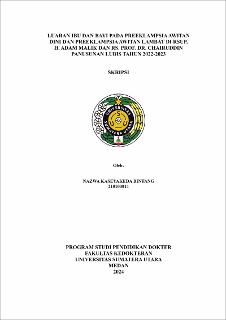| dc.description.abstract | Introduction. Preeclampsia is the third leading cause of maternal death and the
primary cause of neonatal morbidity and mortality. Based on its onset,
preeclampsia is divided into early onset preeclampsia (< 34 weeks) and late onset
preeclampsia (> 34 weeks). Objective. To determine maternal and perinatal
outcomes in early-onset and late-onset preeclampsia. Method. This quantitative
research used a descriptive cross sectional study design, by collecting data through
medical records. The study population consisted of preeclampsia patients and their
newborns from H. Adam Malik General Hospital and Prof. dr. Chairuddin
Panusunan Lubis Hospital in 2022-2023. The research sample consisted of 61
mothers and 61 babies, with early onset preeclampsia occurring in 30 mothers and
late onset preeclampsia in 31 mothers. Results. The distribution of poor maternal
outcomes was more common in early-onset preeclampsia: eclampsia occurred in 1
patient (3.3%), HELLP syndrome in 11 patients (36.7%), pulmonary edema in 2
patients (6.7%), and placental abruption in 2 patients (6.7%), while in late-onset
preeclampsia, the maternal outcomes found were HELLP syndrome (9.7%) and
placental abruption (3.2%). Poor neonatal outcomes were more frequent in mothers
with early-onset preeclampsia, including IUFD in 9 patients (30%), neonatal death
in 10 patients (33.3%), LBW in 15 patients (50%), APGAR scores <7 after 5
minutes in 7 patients (23.3%), and NICU admissions in 18 patients (60%), while in
late-onset preeclampsia, the neonatal outcomes found were IUFD in 6 patients
(19.4%), neonatal deaths in 1 patient (3.2%), LBW in 5 patients (16.1%), APGAR
score < 7 after 5 minutes in 2 patients (6.5%), and NICU admission in 4 patients
(12.9%). Conclusion. Poor maternal and neonatal outcomes were more common
in early-onset preeclampsia. | en_US |


